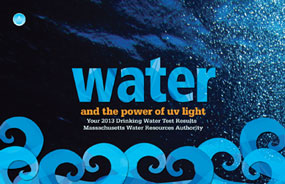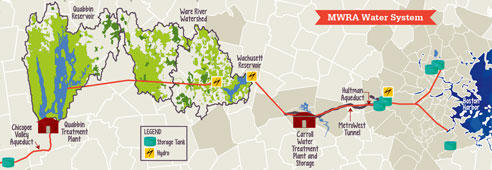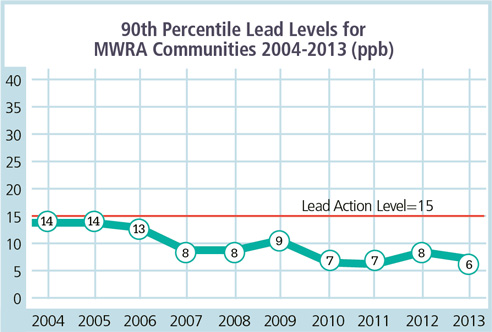| Home |
| Water System |
| Sewer System |
| Harbor and Bay |
| School Program |
| About MWRA |
| Doing Business with MWRA |
| Contact MWRA |
HTML Version- Metro Communities Below are MWRA's 2013 Drinking Water Test Results for MetroWest and Metro Boston communities that receive all of their drinking water from MWRA. Results for partially-supplied communities and Chicopee, South Hadley and Wilbraham are available for download (PDF). This report includes the results of those tests for 2013. This report is required under the federal Safe Drinking Water Act Public Law 104-12, Section 1414 (C), PWS ID #6000000. |
Message from MWRA Executive Director Fred Laskey
|
Where Does Your Water Come From?
|
Your water comes from the Quabbin Reservoir, about 65 miles west of Boston, and the Wachusett Reservoir, about 35 miles west of Boston. These reservoirs supply wholesale water to local water departments in 51 communities. The two reservoirs combined supplied about 200 million gallons a day of high quality water to consumers in 2013.
The Quabbin and Wachusett watersheds are naturally protected with over 85% of the watersheds covered in forest and wetlands. To ensure safety, the streams and reservoirs are tested often and patrolled daily by the Department of Conservation and Recreation (DCR).
Rain and snow falling on the watersheds - protected land around the reservoirs - turn into streams that flow to the reservoirs.
This water comes in contact with soil, rock, plants, and other material as it follows its natural path to the reservoirs. While this process helps to clean the water, it can also dissolve and carry very small amounts of material into the reservoir.
Minerals from soil and rock do not typically cause problems in the water. But, water can also transport contaminants from human and animal activity. These can include bacteria and viruses - some of which can cause illness. The test data in this report show that these contaminants are not a problem in your reservoirs' watersheds.
The Department of Environmental Protection (DEP) has prepared a Source Water Assessment Program report for the Quabbin and Wachusett Reservoirs. The DEP report commends DCR and MWRA on the existing source protection plans, and states that our “watershed protection programs are very successful and greatly reduce the actual risk of contamination.” MWRA follows the report recommendations to maintain the pristine watershed areas using existing watershed plans.
Map of the MWRA Water System
Testing Your Water Every Step of the Way:
2013 Test Results
Test results show few contaminants are found in the reservoir water. The few that are found are in very small amounts, well below EPA's standards. Turbidity (or cloudiness of the water) is one measure of overall water quality. All water must be below 5 NTU (Nephelometric Turbidity Units), and water can only be above 1 NTU if it does not interfere with effective disinfection. Typical levels at the Wachusett Reservoir are 0.3 NTU. In 2013, turbidity was below 1 NTU over 99.99% of the time, with the highest level at 1.17 NTU. This did not interfere with effective disinfection. MWRA also tests reservoir water for pathogens such as fecal coliform, bacteria, viruses, and the parasites Cryptosporidium and Giardia. They can enter the water from animal or human waste. No Cryptosporidium or Giardia was found in the water in 2013.
Test Results - After Treatment
EPA and state regulations require many water quality tests after treatment to check the water you are drinking. MWRA conducts hundreds of thousands of tests per year on over 120 contaminants (a complete list is available on www.mwra.com). Details about 2013 test results are in the table below. The bottom line is that water quality is excellent.
Test Results After Treatment |
|||||||
Details about 2012 are listed. The bottom line is that the water quality is excellent. |
|||||||
Compound |
Units |
(MCL) Highest Level Allowed |
(We found) Detected Level Average |
Range of Detections |
(MCLG) Ideal Goal |
Violation |
How it gets in the water
|
Barium |
ppm
|
2
|
0.008
|
0.007-
0.009 |
2
|
No
|
Common mineral in nature
|
Mono-Chloramine |
ppm
|
4-
MRDL |
1.8
|
0.01-4.0
|
4-
MRDLG |
No
|
Water disinfectant
|
Fluoride |
ppm
|
4
|
1.04
|
0.37-1.1
|
4
|
No
|
Additive for dental health
|
| Nitrate ^ | ppm |
10 |
0.8 |
0.01-0.08 |
10 |
No |
Atmospheric deposition |
Nitrite ^ |
ppm
|
1
|
0.0005
|
ND-0.005
|
1
|
No
|
Byproduct of water disinfection
|
Total Trihalomethanes |
ppb
|
80
|
10.1
|
3.0-13.9 |
ns
|
No
|
Byproduct of water disinfection
|
| Haleoacetic Acids-5 |
ppb |
60 |
9.0 |
1.4-13.2 |
ns |
No |
Byproduct of water disinfection |
Total Coliform |
%
|
5%
|
0.5% (Nov)
|
ND-0.5% |
0
|
No
|
Naturallly present in the environment
|
KEY: MCL=Maximum Contaminant Level. The highest level of a contaminant allowed in water. MCLs are set as close to the MCLGs as feasible using the best available technology. |
|||||||
Tests in Community Pipes
MWRA and local water departments test 300 to 500 water samples each week for total coliform bacteria. Total coliform bacteria can come from the intestines of warm-blooded animals, or can be found in soil, plants, or other places. Most of the time, they are not harmful. However, their presence could signal that harmful bacteria from fecal waste may be there as well. The EPA requires that no more than 5% of the samples in a month may be positive. If a water sample does test positive, we run more specific tests for E.coli, which is a bacteria found in human and animal fecal waste and may cause illness. No E.coli was found in any MWRA community in 2013. If your community found any total coliform, it will be listed within your community's letter.
Ongoing Research for New Regulations
MWRA has been working with EPA and other researchers to define new national drinking water standards by testing for unregulated contaminants. To read more about this testing, and to see a listing of what was found, please visit www.mwra.com/UCMR/2013.html.
Facts About Lead
What You Need to Know about Lead in Tap Water
MWRA water is lead-free when it leaves the reservoirs. MWRA and local pipes that carry the water to your community are made mostly of iron and steel and do not add lead to the water. However, lead can get into tap water through pipes in your home, your lead service line, lead solder used in plumbing, and some brass fixtures. Corrosion or wearing away of lead-based materials can add lead to tap water, especially if water sits for a long time in the pipes before it is used. In 1996, MWRA began adding sodium carbonate and carbon dioxide to adjust the water's pH and buffering capacity. This change has made the water less corrosive, thereby reducing the leaching of lead into drinking water. Lead levels found in sample tests of tap water have dropped by almost 90% since this treatment change.
MWRA Meets Lead Standards in 2012
Under EPA rules, each year MWRA and your local water department must test tap water in a sample of homes that are likely to have high lead levels. These are usually homes with lead service lines or lead solder. The EPA rule requires that 9 out of 10, or 90%, of the sampled homes must have lead levels below the Action Level of 15 parts per billion (ppb). All 18 sampling rounds over the past ten years have been below the EPA standard. Results for the 452 samples taken in September 2013 are shown in the table. 9 out of 10 houses were below 6.3 ppb, which is below the Action Level of 15 ppb. Only two communities had more than one home test above the Action Level for lead. If you live in either of these communities, your community's letter will provide you with more information.
September 2012 Lead and Copper Results |
||||||||||
|---|---|---|---|---|---|---|---|---|---|---|
| Lead (ppb) | Range |
90% Value |
(Target) Action Level |
(Ideal Goal) MCLG |
# Homes above AL/# Homes Tested |
|||||
0-46.9
|
6.3
|
15 |
0 |
8/452 |
||||||
| Copper (ppm) | 0-0.3 |
0.1
|
1.3 |
0 |
0/452 |
|||||
ppb = parts per billion. ppm = parts per million. AL=Action Level-The concentration of a contaminant which, if exceeded, triggers treatment or other requirements which a water system must follow. MCLG=Maximum Contaminant Level Goal The level of contaminant in drinking water below which there is no known or expected risk to health. MCLGs allow for a margin of safety. |
||||||||||
90th Percentile Lead Levels for MWRA Communities: 1992-2013 (ppb) |
||||||||||
|---|---|---|---|---|---|---|---|---|---|---|
| larger image |
What can I do to reduce exposure to lead in drinking water?
- Run the tap until after the water feels cold. To save water, fill a pitcher with fresh water and place in the refrigerator for future use.
- Never use hot water from the faucet for drinking or cooking, especially when making baby formula or other food for infants.
- Ask your local water department if there are lead service lines leading to your home.
- Check your plumbing fixtures to see if they are lead-free. Read the labels closely.
- Test your tap water. Call the MWRA Drinking Water Hotline (617-242-5323) or visit our website for more tips and a list of DEP certified labs that can test your water.
- Be careful of places you may find lead in or near your home. Paint, soil, dust and some pottery may contain lead.
- Call the Department of Public Health at 1-800-532-9571 or EPA at 1-800-424 LEAD for information.
Important Information from EPA about Lead
If present, elevated levels of lead can cause serious health problems, especially for pregnant women and young children. Lead in drinking water is primarily from materials and components associated with service lines and home plumbing. MWRA is responsible for providing high quality drinking water, but cannot control the variety of materials used in plumbing components. If your water has been sitting for several hours, you can minimize the potential for lead exposure by flushing your tap for 30 seconds to 2 minutes before using water for drinking or cooking. If you are concerned about lead in your water, you may wish to have your water tested. Information on lead in drinking water, testing methods, and steps you can take to minimize exposure is available from the Safe Drinking Water Hotline at 1-800-426-4791 or www.epa.gov/safewater/lead.
Important Information from EPA and DEP
Drinking Water and People with Weakened Immune Systems
Some people may be more vulnerable to contaminants in drinking water than the general population. Immuno-compromised persons such as persons with cancer undergoing chemotherapy, persons who have undergone organ transplants, people with HIV/AIDS or other immune system disorders, some elderly, and infants can be particularly at risk from infections. These people should seek advice about drinking water from their health care
providers. EPA/CDC guidelines on appropriate means to lessen the risk of infection by Cryptosporidium and other microbial contaminants are available from the EPA's Safe Drinking Water Hotline (1-800-426-4791).
|
Contaminants in Bottled Water and Tap Water
Drinking water, including bottled water, may reasonably be
expected to contain at least small amounts of some contaminants. The presence of contaminants does not necessarily indicate that water poses a health risk. More information about contaminants and potential health effects can be obtained by calling the EPA’s Safe Drinking Water Hotline (1-800-426-4791) or MWRA. In order to ensure that tap water is safe to drink, the Massachusetts DEP and EPA prescribe regulations which limit the amount of certain contaminants in water provided by public water systems. Food and Drug Administration (FDA) and the Massachusetts Department of Public Health regulations establish limits for contaminants in bottled water.
Sodium in water contributes only a small fraction of a person’s overall sodium intake (less than 10%). MWRA tests for sodium monthly and the highest level found was 35.9 mg/L (about 9 mg per 8 oz. glass). This would be considered Very Low Sodium by the Food and Drug Administration.
Information about Cross Connections
Massachusetts DEP recommends the installation of backflow prevention devices for inside and outside hose connections to help protect the water in your home as well as the drinking water system in your town. For more information on cross connections, please call 617-242-5352 or visit www.mwra.com/crosscon.html.
Water Conservation
Wasting water can add up quickly. On average, each person uses about 65 gallons of water each day. More efficient water use can reduce the impact on the water supply and on your wallet. For ways to make your home and your habits more water efficient, contact the MWRA at 617-242-SAVE or visit our web site for tips on saving water indoors and in your backyard.
Where to Go for More Information
Web Sites and Telephone Numbers |
|
617-242-6000 |
|
617-292-5500 |
|
| Mass. Department of Conservation and Recreation | 617-626-1250 |
617-624-6000 |
|
800-232-4636 |
|
617-242-5323 |
|
| Source Water Assessment and Protection Reports | 617-242-5323 |
| Information on Water Conservation | 617-242-SAVE |
Public Meetings |
|
617-788-1117 |
|
| MWRA Advisory Board | 617-742-7561 |
| Water Supply Citizens Advisory Committee | 413-586-8861 |
Contact Us
If you have questions or comments about this report, please contact us. Call (617) 242-5323, e-mail joshua.das@mwra.com, or write to: MWRA, Charlestown Navy Yard, Building 39, Boston, MA 02129.
Your Community Letter:
Additional Information from Your City or Town Water Department
Read your community letter [PDF] for important information about your water from your city or town water department.
Fully Supplied Communities These communities receive all of their drinking water from MWRA. The water is treated at the Carroll Water Treatment Plant and transmitted via the MetroWest Tunnel. |
|||
| Lexington | Nahant | Somerville | |
| Lynnfield W.D. | Newton | Southborough | |
| Boston | Norwood | Stoneham | |
| Brookline | Quincy | Swampscott | |
| Chelsea | Reading | Waltham | |
| Everett | Revere | Watertown | |
| Framingham | Saugus | Weston | |
| Winthrop | |||
Partially Supplied Communities These communities receive some of their drinking water from MWRA. The MWRA water is treated at the Carroll Water Treatment Plant and transmitted via the MetroWest Tunnel. |
||
| Wilmington | ||
| Canton | Northborough | Winchester |
| Woburn | ||
PDF files on this site require Adobe Acrobat Reader® (Free download.)
Updated June 2, 2014


